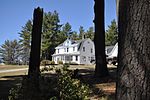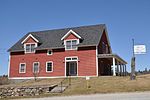Weldwood
Houses completed in 1902Houses in Dublin, New HampshireHouses on the National Register of Historic Places in New HampshireNational Register of Historic Places in Dublin, New Hampshire

Weldwood is a historic summer estate house on Old Troy Road in Dublin, New Hampshire. Built in 1902–03, it is an unusual example of Greek Revival architecture from the early 20th century. The house was listed on the National Register of Historic Places in 1983.
Excerpt from the Wikipedia article Weldwood (License: CC BY-SA 3.0, Authors, Images).Weldwood
Old Troy Road,
Geographical coordinates (GPS) Address Nearby Places Show on map
Geographical coordinates (GPS)
| Latitude | Longitude |
|---|---|
| N 42.888055555556 ° | E -72.106944444444 ° |
Address
Old Troy Road 125
03444
New Hampshire, United States
Open on Google Maps










